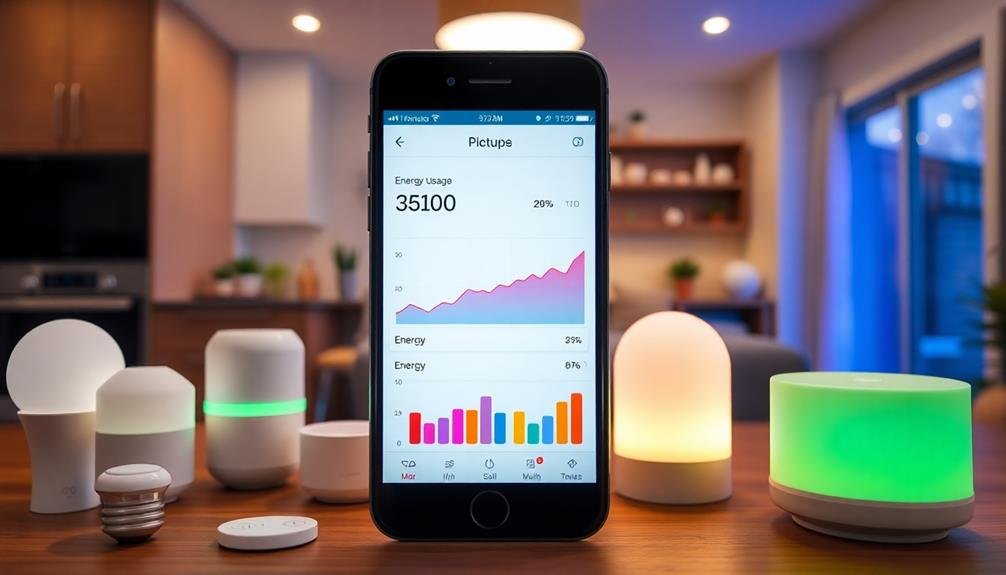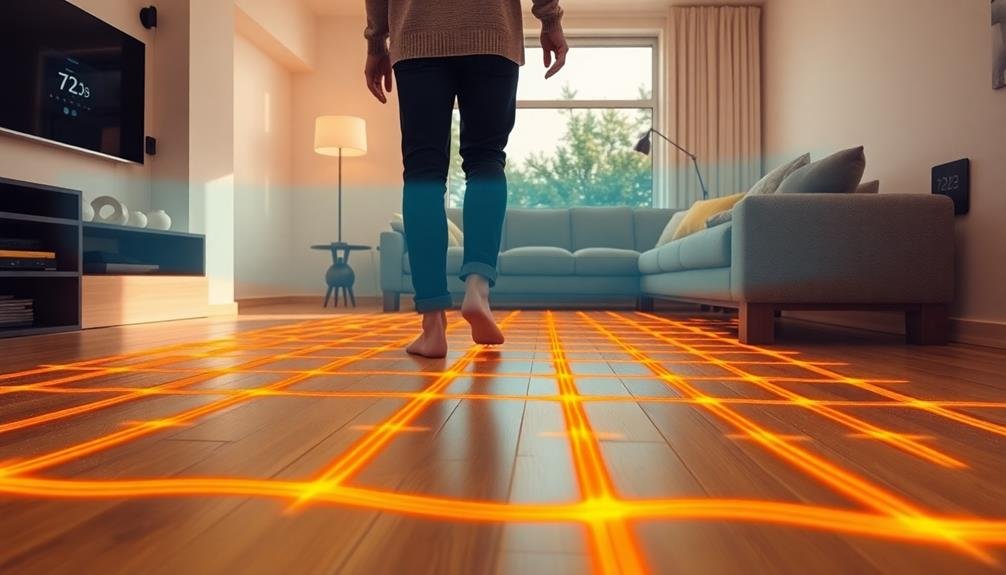Home energy tracking apps empower you to monitor and reduce your household’s power consumption, potentially cutting your energy bills by 10-30%. These apps offer real-time insights into your energy usage, break down consumption by device, and integrate with smart home systems for automated optimization.
You’ll find user-friendly interfaces with intuitive visualizations, customizable alerts, and detailed reports to help you make informed decisions. Popular options include Sense Energy Monitor, Emporia Vue, and Neurio Home Energy Monitor, each offering unique features to suit different needs. By leveraging these tools, you’ll gain valuable insights into your energy habits and reveal opportunities for smarter savings.
Best 9 Home Energy Tracking Apps in 2025
- Sense Home Energy Monitor The Sense app works with their dedicated hardware monitor to provide real-time energy usage insights. What makes Sense stand out is its ability to identify individual appliances through pattern recognition. You’ll see exactly when your refrigerator, washing machine, or HVAC system turns on and how much energy each device consumes. The app offers detailed daily, weekly, and monthly reports, allowing you to track your progress toward energy reduction goals. Users particularly value the notifications for unusual energy usage that can alert you to malfunctioning appliances.
- Emporia Energy Vue Emporia’s app delivers comprehensive energy monitoring with circuit-level precision. When paired with their Vue hardware, you can track individual circuits in your home, making it easier to identify energy hogs. The app features customizable alerts for energy spikes, budget tracking capabilities, and potential savings recommendations. What’s particularly useful is its solar integration, allowing homeowners with solar panels to monitor production alongside consumption in a unified dashboard.
- Flume Water While primarily focused on water monitoring, Flume’s app deserves mention because water heating accounts for a significant portion of home energy usage. The app connects to a sensor on your water meter and provides minute-by-minute usage data, leak detection, and personalized conservation tips. By helping you reduce hot water waste, you’ll see meaningful energy savings. The app also estimates the financial impact of your water usage and sends alerts for potential leaks, potentially saving hundreds in water and energy costs.
- Home Energy Saver This free web-based tool developed by Lawrence Berkeley National Laboratory offers detailed energy analysis without requiring additional hardware. After inputting information about your home’s characteristics, appliances, and usage patterns, you’ll receive personalized recommendations for energy efficiency improvements with estimated costs and savings. While not as automated as hardware-based solutions, it provides comprehensive guidance on the most cost-effective energy upgrades for your specific situation.
- Energy Cost Calculator by Energy.gov This straightforward app from the Department of Energy helps you calculate the operating costs of specific appliances and electronics. Simply enter the wattage of the device, how many hours you use it daily, and your electricity rate to get a clear picture of the annual operating cost. What’s particularly valuable is the comparison feature that shows potential savings when upgrading to more efficient models. It’s an excellent tool for making informed purchasing decisions when replacing energy-consuming appliances.
- Nest Home Beyond controlling Nest thermostats, the Nest Home app provides comprehensive energy monitoring for your heating and cooling systems, which typically account for about 50% of home energy use. The app’s Energy History feature shows exactly when your HVAC system runs and for how long, while the Home Report provides monthly summaries of usage patterns and efficiency. What sets Nest apart is its ability to learn your preferences and automatically optimize for efficiency. The app also integrates with utility companies to participate in demand-response programs, potentially earning you additional rebates or credits.
- WattBuy This innovative app helps users in deregulated energy markets find the most affordable and renewable electricity plans. After analyzing your consumption patterns, WattBuy compares available electricity providers and plans, potentially saving hundreds annually through better rate selection. The app includes a carbon footprint calculator and recommendations for reducing emissions. Users particularly appreciate the transparency in pricing and the ability to switch to cleaner energy sources without necessarily increasing costs.
- Smappee Smappee offers one of the most comprehensive energy monitoring solutions that tracks electricity, gas, and water consumption in a single app. Its standout feature is the ability to detect individual appliance signatures without requiring separate sensors on each device. The app provides real-time monitoring, historical analysis, and personalized energy-saving tips. Solar PV owners will appreciate the solar optimization features that help maximize self-consumption. Smappee also includes automation capabilities, allowing you to turn devices on or off based on energy prices or production levels.
- Eyedro The Eyedro app focuses on simplicity and clarity in energy monitoring. Paired with their hardware sensors, it provides real-time electricity usage data in both kilowatt-hours and dollars, making energy consumption immediately understandable. Users value its straightforward setup and intuitive interface that doesn’t overwhelm with unnecessary features. The app offers customizable alerts for unusual activity and detailed reports that can be exported for further analysis. Eyedro’s comparative analytics also show how your usage compares to similar homes, providing context for your consumption patterns.
Each of these apps offers unique features to help homeowners track, understand, and ultimately reduce their energy consumption. By combining real-time monitoring with actionable insights, they transform complex energy data into practical savings opportunities.
Energy Monitoring App Features

While many energy monitoring apps offer similar core functionalities, the best ones stand out with their extensive feature sets. You’ll find real-time energy usage tracking as a standard feature, allowing you to see your consumption patterns throughout the day.
Look for apps that provide detailed breakdowns of energy use by appliance or room, helping you identify energy hogs in your home.
The most effective apps offer customizable alerts and notifications, warning you when your energy usage spikes or crosses preset thresholds. You’ll also want features like historical data analysis, which lets you compare your current usage to past periods and track improvements over time.
Some advanced apps integrate with smart home devices, enabling you to control connected appliances directly from the app. Others offer energy-saving tips tailored to your specific usage patterns.
Look for apps that provide cost projections based on your energy consumption, helping you budget more effectively.
Consider apps that offer utility bill integration, automatically importing your billing data for more accurate tracking.
Cost-Saving Potential
How much can you really save by using a home energy tracking app? The potential for cost savings is significant, with many users reporting reductions of 10-30% on their energy bills. These savings stem from the app’s ability to identify energy waste and suggest targeted improvements.
You’ll gain insights into your home’s energy consumption patterns, allowing you to make informed decisions about when to use high-energy appliances. Some apps even provide real-time electricity pricing data, enabling you to shift usage to off-peak hours when rates are lower.
By following the app’s personalized recommendations, you can optimize your home’s energy efficiency. This might include adjusting thermostat settings, upgrading to energy-efficient appliances, or sealing air leaks.
The cumulative effect of these changes can lead to substantial savings over time.
Many apps also gamify the energy-saving process, challenging you to reduce consumption and compete with neighbors or friends. This motivational aspect can drive further savings as you become more engaged in energy conservation efforts.
While results vary based on individual circumstances, consistent use of a home energy tracking app can yield impressive cost savings in the long run.
User-Friendly Interface Comparison

When choosing a home energy tracking app, the user interface can make or break your experience. You’ll want an app that’s intuitive, easy to navigate, and presents data in a clear, visually appealing manner.
Let’s compare some popular options:
Sense Energy Monitor offers a sleek, modern interface with color-coded energy usage breakdowns. You’ll appreciate its real-time updates and device-specific consumption data.
Emporia Vue’s interface is straightforward, featuring simple graphs and charts that are easy to interpret at a glance. It’s ideal if you prefer a no-frills approach.
For those who enjoy more detailed analytics, Neurio Home Energy Monitor provides an in-depth dashboard with customizable widgets and reports. You can drill down into specific appliances’ energy usage patterns.
Smappee Energy Monitor boasts an intuitive app design with a user-friendly home screen that displays your energy consumption, solar production, and real-time power use.
Eyedro’s interface stands out with its interactive energy graphs and ability to set personalized alerts. You’ll find it easy to track your energy goals and receive notifications when you exceed predefined limits.
Consider your personal preferences and technical comfort level when selecting the app that best suits your needs.
Data Visualization and Reporting
You’ll find that data visualization is a key feature in top home energy tracking apps.
These apps offer interactive charts and graphs, allowing you to easily spot trends and patterns in your energy usage.
With customizable energy reports and real-time consumption insights, you’re empowered to make informed decisions about your energy habits and potentially reduce your bills.
Interactive Charts and Graphs
Nearly all home energy tracking apps offer interactive charts and graphs to help you visualize your energy consumption data. These visual tools transform complex information into easy-to-understand formats, allowing you to quickly grasp your energy usage patterns and identify areas for improvement.
You’ll typically find a variety of chart types, including:
- Line graphs showing energy consumption over time
- Bar charts comparing usage across different appliances or rooms
- Pie charts illustrating the breakdown of energy costs
These interactive features let you customize your view by selecting specific time periods, appliances, or energy sources. You can zoom in on particular days or weeks to analyze your consumption in detail or zoom out to see long-term trends.
Many apps also offer the ability to overlay weather data on your energy usage graphs, helping you understand how external factors impact your consumption.
Customizable Energy Reports
Building on the interactive visual tools, many home energy tracking apps offer customizable energy reports. These reports allow you to tailor the information you receive, focusing on the aspects of your energy consumption that matter most to you. You’ll be able to set specific parameters, such as date ranges, appliance categories, or energy-saving goals, to generate reports that align with your interests.
Customizable reports often include options for comparing your energy use across different time periods, helping you identify trends and patterns in your consumption. You can create weekly, monthly, or yearly summaries, making it easier to track your progress over time.
Some apps even let you benchmark your energy use against similar households in your area, giving you a clear picture of how you stack up.
Many apps offer the ability to export these reports in various formats, such as PDF or spreadsheet files, allowing you to share them with family members or energy consultants. You can also set up automated report delivery, ensuring you receive regular updates on your energy consumption without having to manually generate them each time.
Real-Time Consumption Insights
A digital dashboard lights up with real-time energy consumption data, offering users instant insights into their home’s power usage.
These real-time consumption insights allow you to monitor your energy use as it happens, empowering you to make immediate adjustments and see the impact of your actions.
With advanced data visualization tools, you’ll be able to quickly grasp complex information through intuitive graphs, charts, and color-coded displays.
These visual representations help you identify patterns, spot energy-hungry appliances, and understand your consumption habits at a glance.
Real-time insights provide several benefits:
- Immediate feedback on energy-saving actions
- Detection of unexpected spikes in consumption
- Ability to correlate energy use with specific activities or times of day
Integration With Smart Devices

You’ll find that modern home energy tracking apps seamlessly connect with your smart home devices, enabling thorough monitoring of your energy usage.
These apps provide real-time data on individual device consumption, allowing you to identify energy hogs and adjust usage patterns accordingly.
Seamless Smart Home Connectivity
Many of today’s home energy tracking apps go beyond simple monitoring by seamlessly integrating with your smart home devices.
These apps can communicate with various connected appliances and sensors, allowing you to control and optimize your energy usage from a single interface. You’ll be able to adjust your thermostat, manage lighting, and even control smart plugs directly from your energy tracking app.
This seamless connectivity offers several advantages:
- Real-time data: Get instant updates on energy consumption from individual devices
- Automated routines: Set up energy-saving schedules based on your habits and preferences
- Remote control: Manage your home’s energy use even when you’re away
Real-Time Device Monitoring
Building on the concept of seamless connectivity, real-time device monitoring takes smart home integration to the next level. With this feature, you’ll gain instant insights into your home’s energy consumption, broken down by individual devices and appliances. You can track which items are using the most power and when, allowing you to make informed decisions about your energy usage.
Many energy tracking apps now offer real-time monitoring of smart plugs, thermostats, lighting systems, and major appliances. You’ll receive notifications when devices are left on unnecessarily or when energy usage spikes unexpectedly. This immediate feedback empowers you to take swift action, turning off devices remotely or adjusting settings to enhance efficiency.
Some apps even provide device-specific recommendations, suggesting ideal usage times based on your local energy rates and consumption patterns. You can set custom alerts for specific devices, ensuring you’re always in control of your energy usage.
Automated Energy Optimization
Automation takes center stage in the next evolution of home energy management. Advanced energy tracking apps now integrate seamlessly with smart home devices, allowing you to optimize your energy usage without lifting a finger.
These intelligent systems analyze your consumption patterns and automatically adjust your home’s energy settings for maximum efficiency.
You’ll find that many apps can:
- Control smart thermostats to optimize heating and cooling schedules
- Manage smart plugs to turn off idle devices
- Adjust smart lighting based on occupancy and natural light levels
By connecting your energy tracking app to your smart home ecosystem, you’re creating a powerful network that works tirelessly to reduce your energy waste. The app uses machine learning algorithms to fine-tune your home’s energy profile, adapting to your lifestyle and preferences over time.
You’ll receive notifications about potential energy-saving opportunities and can often set custom rules for different scenarios. For example, you might program the system to automatically lower the thermostat and turn off non-essential devices when you leave for work.
As these systems become more sophisticated, they’ll even factor in weather forecasts and energy pricing to make real-time adjustments that maximize your savings while maintaining comfort.
Privacy and Security Measures
While home energy tracking apps offer valuable insights into your consumption patterns, they also raise important privacy and security concerns. You’ll want to guarantee that your personal data and usage information remain protected from unauthorized access or breaches.
When choosing an energy tracking app, look for robust security features such as:
| Security Measure | Purpose |
|---|---|
| End-to-end encryption | Protects data in transit |
| Two-factor authentication | Prevents unauthorized access |
| Regular security audits | Identifies vulnerabilities |
| Data anonymization | Safeguards personal information |
It’s essential to read the app’s privacy policy carefully and understand how your data will be collected, stored, and used. Look for apps that allow you to control your data sharing preferences and offer options to delete your information upon request.
Be cautious about granting unnecessary permissions to the app, such as access to your location or contacts. Only provide the essential information required for the app to function effectively. Additionally, keep your app and device software up-to-date to benefit from the latest security patches and improvements. By taking these precautions, you’ll be able to enjoy the benefits of energy tracking while minimizing potential risks to your privacy and security.
Frequently Asked Questions
Can These Apps Work With Older, Non-Smart Appliances?
Yes, many energy tracking apps can work with older appliances. You’ll need to manually input data or use smart plugs to monitor non-smart devices. Some apps also estimate usage based on appliance type and age.
Are There Any Free Energy Tracking Apps Available?
You’ll find several free energy tracking apps available. They offer basic features like consumption monitoring and bill estimates. However, you might encounter limited functionality or ads. For more advanced features, you’ll likely need paid versions.
How Accurate Are the Energy Consumption Predictions in These Apps?
You’ll find energy consumption predictions in these apps are generally accurate, but they’re not perfect. They rely on your input and smart meter data. Your usage patterns and weather changes can affect accuracy, so regular updates improve predictions.
Do I Need Special Hardware to Use Home Energy Tracking Apps?
You don’t always need special hardware. Many apps work with your existing smart meter or utility data. However, some apps offer enhanced features when paired with smart plugs or energy monitors you can install yourself.
Can Multiple Household Members Use the Same App Account Simultaneously?
You’ll find most energy tracking apps allow multiple users on one account. You can usually add family members or roommates, letting everyone monitor and contribute to energy savings. Check your app’s settings for specific sharing options.
In Summary
You’ve explored the top home energy tracking apps that can lead to smart savings. By leveraging these apps’ features, you’re empowering yourself to make informed decisions about your energy consumption. Remember, the best app for you will balance cost-saving potential, user-friendliness, and robust data visualization. As you integrate these tools with your smart devices, don’t forget to prioritize privacy and security. With the right app, you’ll be well on your way to reducing your energy bills and carbon footprint.





Leave a Reply